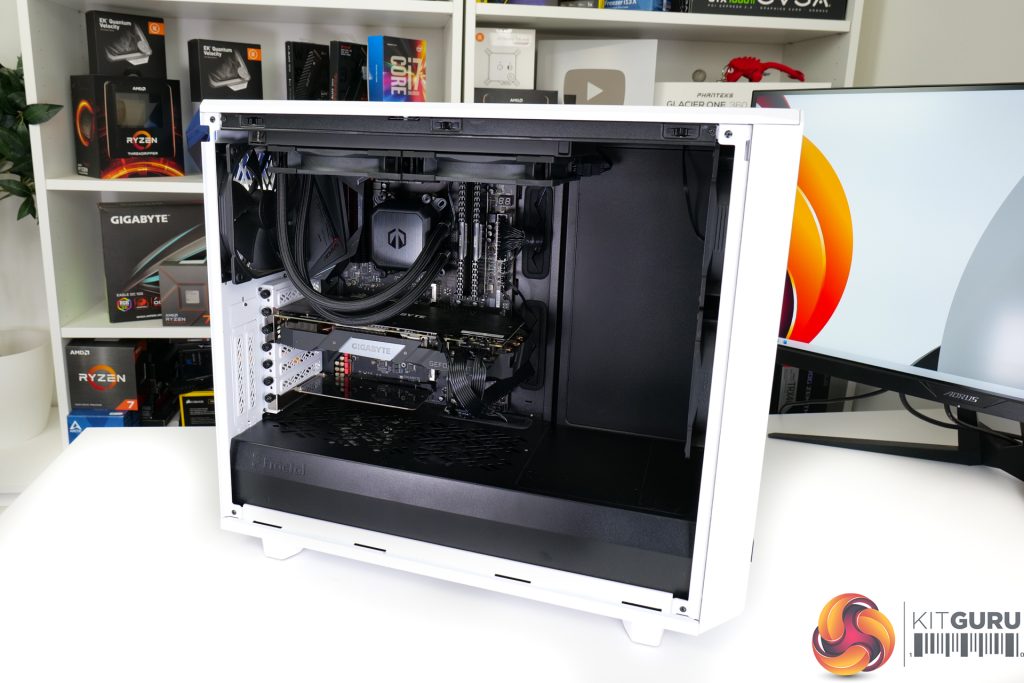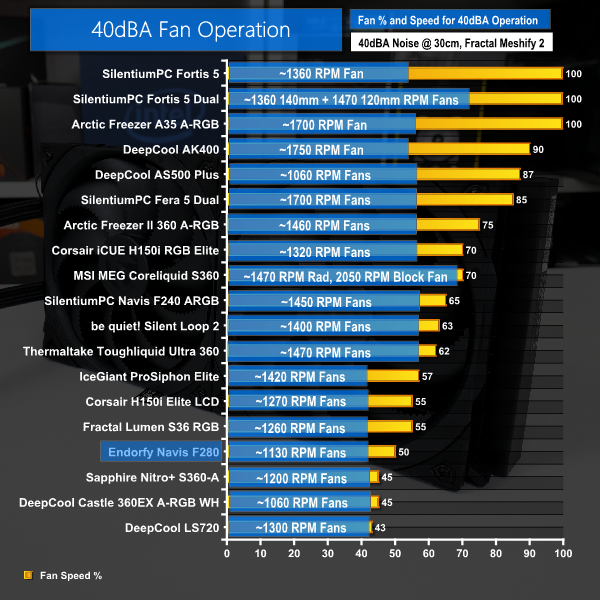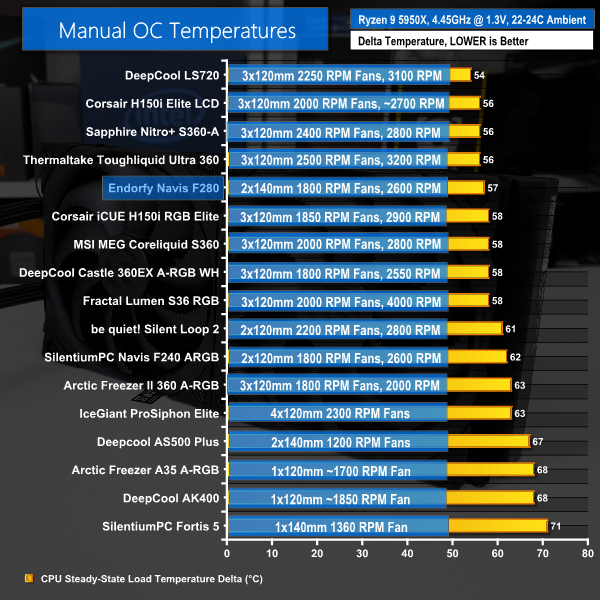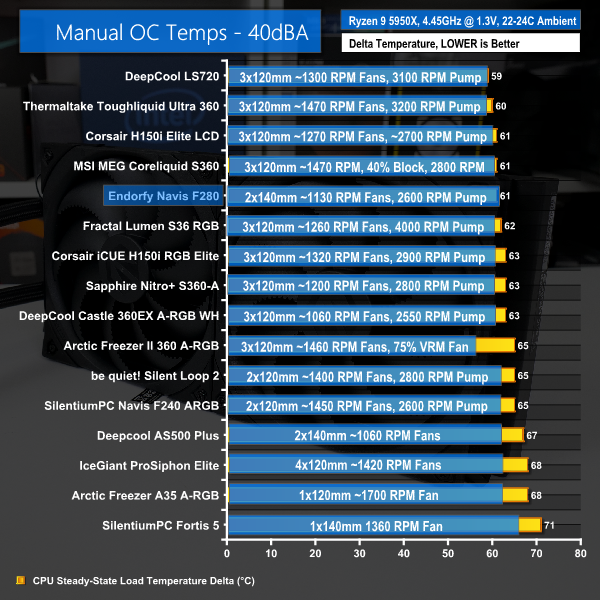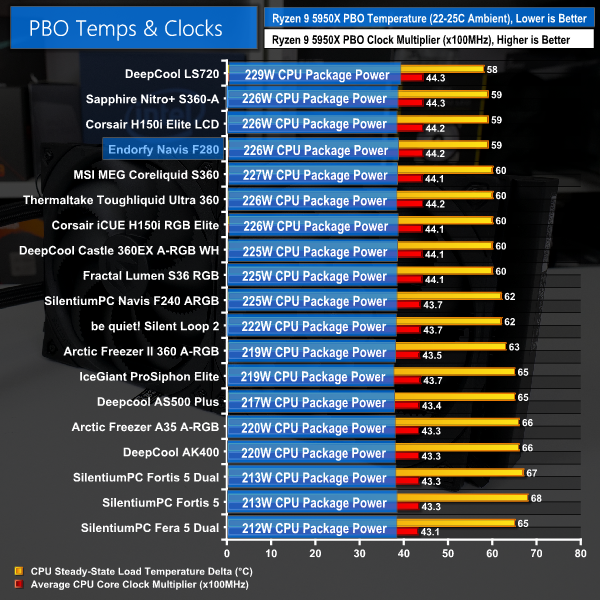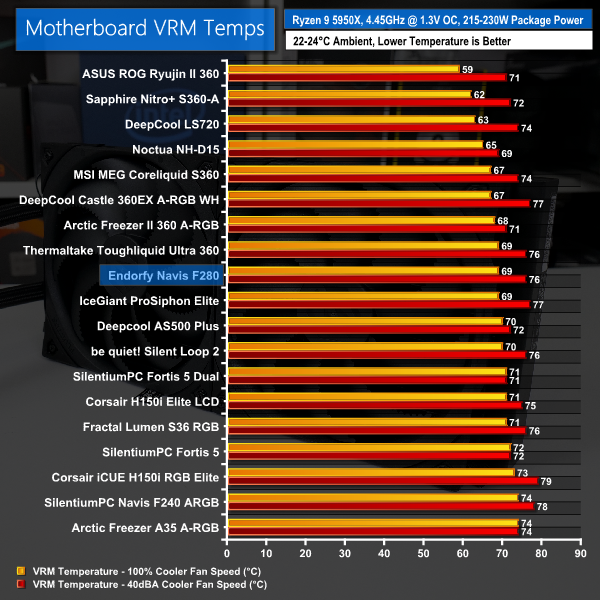Test System:
- Processor: AMD Ryzen 9 5950X
- Overclocked Settings: 4.45GHz all-core @ 1.312V (UEFI), Medium LLC – around 1.3V delivered
- Motherboard: Gigabyte B550 Aorus Master
- Memory: 32GB (2x16GB) Corsair Vengeance LPX 3600MHz 16-18-18-36 DDR4 @ 1.35V
- Graphics Card: Gigabyte RTX 2060 Super 0dB Mode
- Chassis: Fractal Design Meshify 2
- Chassis Fans: 2x140mm 1000 RPM Fractal Front Intake, 1x140mm 1000 RPM Fractal Rear Exhaust, 1x140mm 1000 RPM be quiet! Pure Wings 2 Roof Exhaust (for air cooler testing)
- Power Supply: Seasonic Prime TX-1000
- Operating System: Windows 10 Pro 64-bit
Testing Methodology:
- For testing, we use a 30-minute looped run of Cinebench R23 and record the steady-state CPU temperature at the end of the test. This ensures that the CPU has had ample time to warm up and reach steady state under all of the coolers.
- Ambient is maintained around 22-24 degrees Celsius. Where there is variation beyond this temperature range, we add in extra repeated tests to ensure consistency.
- We also test each cooler with at least two fresh installs (typically three) to mitigate the likelihood of a dodgy mount spoiling results.
Test Results:
Acoustics
Let’s start off with noise performance at 100% fan speed. This is important for getting an indication of where our performance expectations should lie based on noise output.
Running at 49 dBA in our test system, noise output from the Endorfy Navis F280 is very much audible but about average when it comes to liquid coolers. The noise output is very slightly higher than the 240mm ARGB version of the Navis.
It is promising that there’s the strong 250-1800 RPM PWM curve of the fans to further improve noise output. That’s very helpful if your motherboard has good control abilities.
In order to get the unit running at 40 dBA, we had to restrict the pair of fans down to 50% fan speed. This translated into around 1130 RPM operating speed according to software readings.
Cutting about half off the fan speeds to hit 40 dBA noise output is a heavy price to pay and indicates that the pair of Fluctus 140 PWM fans are not very noise efficient. Clearly, there is headroom to ramp up performance when needed, but 50% duty cycle is a considerable speed cut.
Thermal Performance
Full-speed performance cooling an overclocked Ryzen 9 5950X processor is very strong from Endorfy. The 280mm Navis F280 is a handful of degrees better than its 240mm ARGB sibling. And Endorfy’s new dual-140mm cooler even manages to hang with the 360mm crowd quite comfortably.
This is promising, top-end cooling performance.
When locked at 40 dBA noise output, the Endorfy Navis F280 still manages to maintain its healthy, highly-competitive Ryzen 5000-based cooling performance. The 280mm cooler is once again a few degrees ahead of its 240mm sibling, and it has little problem hanging with some of the highly-competitive 360mm cooler pack, too.
As always, it is critical to note that small difference in the displayed delta temperatures are not as important for our PBO testing because the clock speed and cooling power achieved are more important metrics.
Switching back to full fans speeds and with the processor running in Precision Boost Overdrive mode, once again, we see very strong performance from the Endorfy Navis F280 cooler that has it trading blows with 360mm AIOs from the likes of Asetek.
In fact, the Navis F280 manages a clock speed and power handled rating that is very close to the best showing on our chart. This is highly impressive.
VRM cooling performance is perfectly fine for the dual-140mm Endorfy cooler. That’s the case with the cooler running at 100% fan speed. Though the performance is less impressive when locked to 40 dBA noise output fan speeds.
 KitGuru KitGuru.net – Tech News | Hardware News | Hardware Reviews | IOS | Mobile | Gaming | Graphics Cards
KitGuru KitGuru.net – Tech News | Hardware News | Hardware Reviews | IOS | Mobile | Gaming | Graphics Cards


